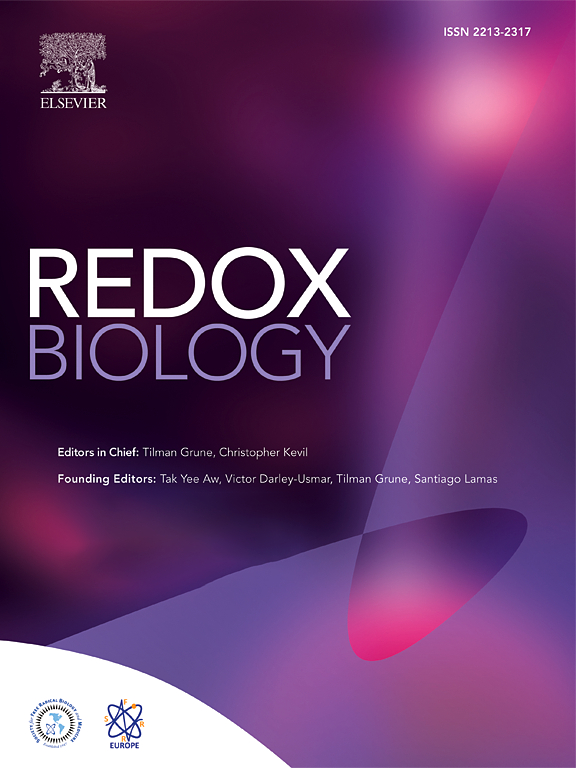红细胞来源的微颗粒通过在血管内溶血中触发内皮细胞铁下垂诱导肾损伤
IF 10.7
1区 生物学
Q1 BIOCHEMISTRY & MOLECULAR BIOLOGY
引用次数: 0
摘要
血管内溶血是一种常见的事件在许多疾病的发病机制与异质性的病因和临床特征。大量溶血的常见不良反应是肾损伤,这是慢性溶血疾病发病率和死亡率增加的主要原因。然而,红细胞衍生微粒(RMPs)和内皮细胞(ECs)之间的串扰在溶血中的作用仍然未知,特别是在溶血介导的肾损伤中。为了回答这个问题,我们建立了溶血源性RMPs和ECs的体外共孵育模型,以及静脉注射溶血RMPs的小鼠模型。我们发现大量内化的RMPs通过铁过载、氨基酸代谢紊乱和miR-130a/ACSL4轴参与了ECs的铁凋亡。此外,rmp诱导的内皮性铁下垂可增强小鼠氧化应激,加重组织病理学损伤,促进肾功能丧失。这些病理效应在小鼠上吊铁抑制剂铁他汀-1 (fer1)和去铁胺(DFO)处理后显著改善。总之,我们的研究表明,rmps诱导的内皮细胞铁下垂在溶血肾损伤的发生和进展中起重要作用,抑制铁下垂可能是预防严重溶血危象患者肾损伤的潜在治疗方法。本文章由计算机程序翻译,如有差异,请以英文原文为准。
Red blood cell-derived microparticles induce kidney injury by triggering endothelial cell ferroptosis in intravascular hemolysis
Intravascular hemolysis is a common event in the pathogenesis of numerous diseases with heterogeneous etiologies and clinical features. A frequent adverse effect of massive hemolysis is kidney injury, which is a major cause of increased morbidity and mortality in chronic hemolytic diseases. However, the role of crosstalk between red blood cell-derived microparticles (RMPs) and endothelial cells (ECs) in hemolysis remains unknown, especially in hemolysis-mediated kidney injury. To answer this question, we established an in vitro co-incubation model of hemolysis-derived RMPs and ECs as well as a mouse model intravenously injected with hemolytic RMPs. We found that a large number of internalized RMPs contributed to the ferroptosis of ECs via iron overload, amino acid metabolism disorder, and the miR-130a/ACSL4 axis. Furthermore, RMPs-induced endothelial ferroptosis could enhance oxidative stress, aggravate histopathological damage, and promote loss of renal function in mice. These pathological effects were significantly ameliorated in mice treated with ferroptosis inhibitors ferrostatin-1 (Fer-1) and deferoxamine (DFO). In conclusion, our study demonstrated that RMPs-induced ferroptosis of ECs plays an important role in the development and progression of kidney damage associated with hemolysis, and inhibition of ferroptosis may be a potential therapeutic approach to prevent renal injury in patients with severe hemolytic crisis.
求助全文
通过发布文献求助,成功后即可免费获取论文全文。
去求助
来源期刊

Redox Biology
BIOCHEMISTRY & MOLECULAR BIOLOGY-
CiteScore
19.90
自引率
3.50%
发文量
318
审稿时长
25 days
期刊介绍:
Redox Biology is the official journal of the Society for Redox Biology and Medicine and the Society for Free Radical Research-Europe. It is also affiliated with the International Society for Free Radical Research (SFRRI). This journal serves as a platform for publishing pioneering research, innovative methods, and comprehensive review articles in the field of redox biology, encompassing both health and disease.
Redox Biology welcomes various forms of contributions, including research articles (short or full communications), methods, mini-reviews, and commentaries. Through its diverse range of published content, Redox Biology aims to foster advancements and insights in the understanding of redox biology and its implications.
 求助内容:
求助内容: 应助结果提醒方式:
应助结果提醒方式:


